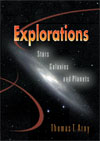Earth is a beautiful planet. Even from space we can see its beauty--blue seas,
green jungles, red deserts, and white clouds. Much of our appreciation of the
Earth comes from knowing that it is home for us and the billions of other living
things that share this special and precious corner of the Universe. But why
study Earth in an astronomy course? The reason is simple: we know Earth better
than any other astronomical body, and we can learn from it about many of the
properties that shape other worlds. Earth's special characteristics result in large measure from its dynamic
nature. The Earth is not a dead ball of rock; both its surface and its atmosphere
have changed greatly during its vast lifetime. Below our feet the ground sometimes
trembles and wrenches in response to dynamic forces even today, crumpling our
planet's crust into mountains, stretching it, and tearing it open to form new
ocean basins. These slow but violent motions within the Earth arise from heat generated
deep within. That heat also drives volcanic eruptions, which vent gases and
molten rock. Over billions of years, such gases accumulated, in part creating
our atmosphere, an atmosphere that has itself been changed by the presence of
abundant water and life. |



 2002 McGraw-Hill Higher Education
2002 McGraw-Hill Higher Education

 2002 McGraw-Hill Higher Education
2002 McGraw-Hill Higher Education